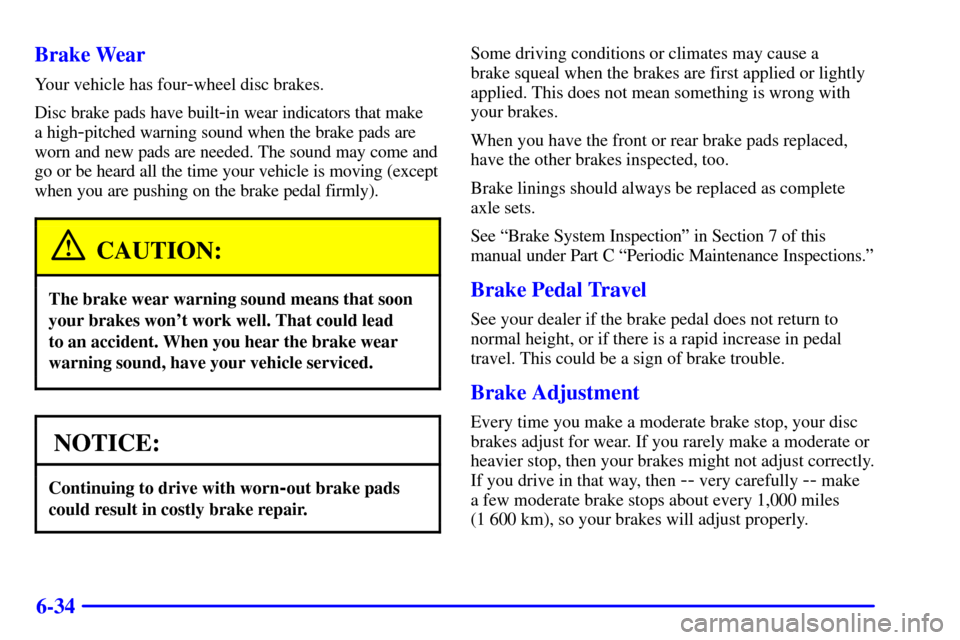Page 283 of 357

6-32
There are only two reasons why the brake fluid level in
the reservoir might go down. The first is that the brake
fluid goes down to an acceptable level during normal
brake lining wear. When new linings are put in, the fluid
level goes back up. The other reason is that fluid is
leaking out of the brake system. If it is, you should
have your brake system fixed, since a leak means that
sooner or later your brakes won't work well, or won't
work at all.
So, it isn't a good idea to ªtop offº your brake fluid.
Adding brake fluid won't correct a leak. If you add fluid
when your linings are worn, then you'll have too much
fluid when you get new brake linings. You should add
(or remove) brake fluid, as necessary, only when work is
done on the brake hydraulic system.
CAUTION:
If you have too much brake fluid, it can spill on
the engine. The fluid will burn if the engine is hot
enough. You or others could be burned, and your
vehicle could be damaged. Add brake fluid only
when work is done on the brake hydraulic system.
When your brake fluid falls to a low level, your brake
warning light will come on. See ªBrake System Warning
Lightº in the Index.
Checking Brake Fluid
You can check the brake fluid without taking off the
cap. Just look at the brake fluid reservoir. The fluid level
should be above the plastic seam in the reservoir (A).
If it isn't, have your brake system checked to see if
there is a leak.
Page 285 of 357

6-34 Brake Wear
Your vehicle has four-wheel disc brakes.
Disc brake pads have built
-in wear indicators that make
a high
-pitched warning sound when the brake pads are
worn and new pads are needed. The sound may come and
go or be heard all the time your vehicle is moving (except
when you are pushing on the brake pedal firmly).
CAUTION:
The brake wear warning sound means that soon
your brakes won't work well. That could lead
to an accident. When you hear the brake wear
warning sound, have your vehicle serviced.
NOTICE:
Continuing to drive with worn-out brake pads
could result in costly brake repair.
Some driving conditions or climates may cause a
brake squeal when the brakes are first applied or lightly
applied. This does not mean something is wrong with
your brakes.
When you have the front or rear brake pads replaced,
have the other brakes inspected, too.
Brake linings should always be replaced as complete
axle sets.
See ªBrake System Inspectionº in Section 7 of this
manual under Part C ªPeriodic Maintenance Inspections.º
Brake Pedal Travel
See your dealer if the brake pedal does not return to
normal height, or if there is a rapid increase in pedal
travel. This could be a sign of brake trouble.
Brake Adjustment
Every time you make a moderate brake stop, your disc
brakes adjust for wear. If you rarely make a moderate or
heavier stop, then your brakes might not adjust correctly.
If you drive in that way, then
-- very carefully -- make
a few moderate brake stops about every 1,000 miles
(1 600 km), so your brakes will adjust properly.
Page 313 of 357
6-62
Main Fuse Block
Fuse Usage
STOP/HAZARD Hazard Flashers, Brake
Switch Assembly
TURN B/U Traction Control/Second
-Gear
Start Switch, Back
-Up Lamp
Switch, Turn Flasher, Daytime
Running Lamps (DRL) Module
STG WHL
CNTRLSteering Wheel ControlsFuse Usage
RADIO ACCY Delco Monsoon Radio Amplifier,
Remote CD Player (Trunk)
TAIL LPS Daytime Running Lamps (DRL)
Module, Headlamp Switch
HVAC HVAC Selector Switch,
Rear Defogger Switch/Timer
PWR ACCY Parking Lamp Relay, Hatch
Release Relay, Power Mirror
Switch, Radio, Shock Sensor,
Instrument Cluster
COURTESY Body Control Module (BCM)
GAUGESBody Control Module (BCM),
Brake
-Transmission Shift Interlock
(BTSI), Instrument Cluster,
Daytime Running Lamps
(DRL) Module
AIR BAG Air Bag System
CIG/ACCY Cigarette Lighter, Data Link
Connector (DLC)
DEFOG/SEATS Rear Defogger Switch/Timer,
Power Seats
Page:
< prev 1-8 9-16 17-24